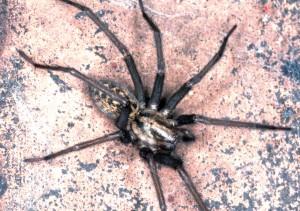House Spiders Tegenaria and Eratigena spp.

There are five species of 'House Spider' - the big hairy ones that come out at night and occasionally end up in the bath. These large, long-legged, brown spiders produce a sheet web that leads to a tubular retreat.
- Tegeneria domestica (Common House Spider), body size up to 10mm
- Eratigena atrica body size up to 18mm
- Eratigena duellica (Cobweb Spider), body size up to 18mm
- Tegeneria parietina (Cardinal Spider), body size up to 20mm
- Eratigena saeva, body size up to 18mm
- Closely related to these is Eratigena agrestis, with a body size up to 15mm, which is found on waste ground and open grassland.
The Species
Tegenaria domestica
The smallest of the four and is found throughout Britain. Although virtually reliant on people's houses, this species can be found in cave entrances and inside hollow trees. Like the other Tegenaria and Eratigena species, they spin a sheet web that leads to a tubular retreat, in a corner if a room or behind a piece of furniture. Strands of silk extend beyond the main platform of the web forming a tangle of lines. Females hang their dirty-white egg sacs from ledges using a few strands of silk.
Eratigena atrica
Eratigena atrica produces a typical sheet web like that of T. domestica, but larger. It occurs in houses and out-buildings as well as outside and is, in appearance, identical to E. duellica and E. saeva. This species is very localised in Britain, occurring only in the greater Newcastle-upon-Tyne area and around Perth/Dundee.
Eratigena duellica
Eratigena duellica is identical in its appearance, web and biology to E. atrica and E. saeva. It is common and widespread across the east of England and the Midlands, giving way to E. saeva in the west. In northern England and Scotland the two species co-occur. As well as in houses, it can be found in crevices, under stones and logs, and holes in banks.
Eratigena saeva
Eratigena saeva is identical in its appearance, web and biology to E. atrica and E. duellica. It is common in the West Country and across Wales, and is replaced by E. duellica in the east. In northern England and Scotland the two species co-occur in very similar habitats.The northern and western British equivalent of Tegenaria gigantea and can be found in similar circumstances.
Tegenaria parietina
Tegenaria parietina gets its common name 'Cardinal Spider' from the story that the spiders living in Hampton Court used to terrify Cardinal Wolseley. This species has longer and more hairy legs than Eratigena atrica, E. duellica and E. saeva, which it matches in size. The sheet web is larger than that of these Eratigena species. Tegenaria parietina occurs in the south of England, but not the extreme southwest. Because of their size, some consider T. parientina to be the most frightening night prowler.
Additional Information
Tegenaria and Eratigena species very rarely bite and if they do it is painless. What gives them a bad reputation is their size, speed and nocturnal habits. Females can live for several years, but males, who live for a few weeks with the female, die after mating and are sometimes consumed by the female. Like all spiders living in houses they can withstand the very dry conditions and survive for months without sustenance.
